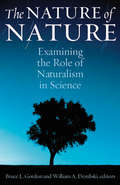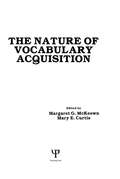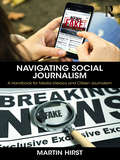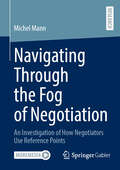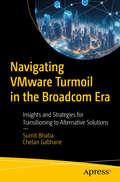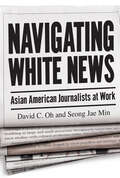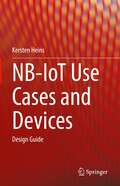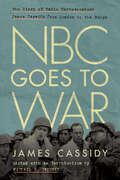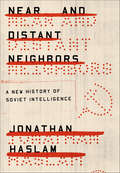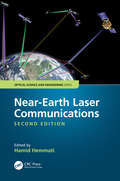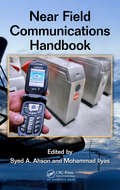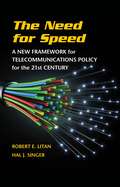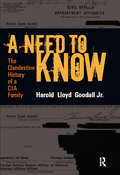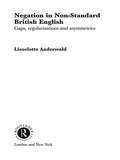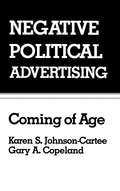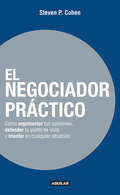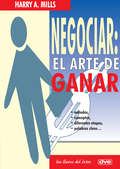- Table View
- List View
The Nature of Nature: Examining the Role of Naturalism in Science
by William Dembski Bruce GordonThe intellectual and cultural battles now raging over theism and atheism, conservatism and secular progressivism, dualism and monism, realism and antirealism, and transcendent reality versus material reality extend even into the scientific disciplines. This stunning new volume captures this titanic clash of worldviews among those who have thought most deeply about the nature of science and of the universe itself.Unmatched in its breadth and scope, The Nature of Nature brings together some of the most influential scientists, scholars, and public intellectuals--including three Nobel laureates--across a wide spectrum of disciplines and schools of thought. Here they grapple with a perennial question that has been made all the more pressing by recent advances in the natural sciences: Is the fundamental explanatory principle of the universe, life, and self-conscious awareness to be found in inanimate matter or immaterial mind? The answers found in this book have profound implications for what it means to do science, what it means to be human, and what the future holds for all of us.
The Nature of Vocabulary Acquisition
by Margaret G. McKeown Mary E. CurtisFirst published in 1987. Routledge is an imprint of Taylor & Francis, an informa company.
Nature Power
by Wendy Wickwire Harry RobinsonMany of the stories in Okanagan storyteller Harry Robinson's second collection feature the shoo-MISH, or "nature helpers" that assist humans and sometimes provide them with special powers. Some tell of individuals who use these powers to heal themselves; others tell of Indian doctors with the power to heal others. Still others tell of power encounters of various kinds.
Navigating a Career in Technical Entertainment: Your Creative Career Guidebook
by Jessica Champagne Hansen Camille SchenkkanNavigating a Career in Technical Entertainment: Your Creative Career Guidebook explores tools, strategies, and motivational advice from a wide range of industry professionals for navigating an artistic career in design and technology in entertainment. This book is designed to accompany readers every step of the way in their career journey – from landing their first job after school through mid-career pivots and switching industries. It is organized into four parts: Finding Your Career Path; Tools and Strategies for Navigating Your Career Path; Curating a Creative Community as You Sustain Your Career; and Maintaining Flexibility and Finding Fulfillment in Your Career. Filled with motivational advice from mentors in the industry and creative worksheet exercises for personalized career planning, self- reflection, and goal setting, this book demystifies a complex industry, sharing crucial career-related information rarely covered in formal training programs. It explores a wide range of topics, including the types of jobs available in live entertainment and TV/film, education options, job searching, networking, career marketing materials, interviews, unions, financial empowerment, and refocusing on career shifts. This guidebook is written for designers, technicians, stage managers, production managers, crew members, and creative technical artists in entertainment at all stages of their career. Covering a wide variety of entertainment from theater and television to commercials and theme parks, Navigating a Career in Technical Entertainment is a perfect companion for higher education or postsecondary educators and students exploring career and workforce readiness topics and can also be used by professionals actively working in the field. This text also includes access to downloadable versions of the worksheets featured in the book, available at www.routledge.com/9780367510442.
Navigating a Toxic Workplace For Dummies
by Catherine MatticeThis friendly, compassionate guide is the antidote to workplace toxicity Toxic workplaces can be bad for your mental and physical health, and they're one of the leading causes of employee turnover. Navigating a Toxic Workplace For Dummies explores what causes work environments to turn sour, and what you—as an employee, manager or leader—can do about it. You'll learn why people engage in toxic behavior like bullying, harassment, exclusion, and disrespect at work. More importantly, you'll gain the tools and skills to counter that behavior with positivity. Every individual, at every level of an organization, can make a difference in detoxifying the workplace. Don't let the stress of your job environment weigh you down. Let this Dummies guide teach you to support yourself and the people around you. Discover the signs and symptoms of a toxic workplace Learn why people do toxic things, and how to protect yourself Get advice on reporting harassment and other behaviors to HR Understand how to make organizational change as a manager, HR or leader Lead your organization in a detoxification campaign Navigating a Toxic Workplace For Dummies is a must for anyone who has dealt with or is currently dealing with a toxic situation at work, as well as managers and leaders committed to resolving toxic situations.
Navigating Social Journalism: A Handbook for Media Literacy and Citizen Journalism
by Martin HirstPublic trust in the once powerful institutions of the News Establishment is declining. Sharing, curating and producing news via social media channels may offer an alternative, if the difficult process of verification can be mastered by social journalists operating outside of the newsroom. Navigating Social Journalism examines the importance of digital media literacy and how we should all be students of the media. Author Martin Hirst emphasizes the responsibility that individuals should take when consuming the massive amounts of media we encounter on a daily basis. This includes information we gather from online media, streaming, podcasts, social media and other formats. The tools found here will help students critically evaluate any incoming media and, in turn, produce their own media with their own message. This book aims both to help readers understand the current state of news media through theory and provide practical techniques and skills to partake in constructive social journalism.
Navigating Through the Fog of Negotiation: An Investigation of How Negotiators Use Reference Points
by Michel MannNegotiations are an integral part of our daily lives, but they can also be challenging and complex. To successfully navigate the fog of negotiation, people rely on reference points—comparison standards for evaluating potential and final negotiation outcomes. They enable negotiators to make smart decisions and take effective action despite difficult circumstances. But how do these reference points emerge? What functions do they serve in negotiations? And how can they be utilized to shape outcomes? This book delves into the psychology of reference points in negotiations, exploring how they influence decision-making, behavior and negotiated outcomes. By uncovering their mechanisms, this work provides insights for understanding, predicting and refining negotiation techniques—essential knowledge for researchers, professionals and anyone aiming to negotiate more effectively.
Navigating VMware Turmoil in the Broadcom Era: Insights and Strategies for Transitioning to Alternative Solutions
by Sumit Bhatia Chetan GabhaneFor the past two decades, VMware has dominated the infrastructure virtualization space, with organizations relying heavily on its ESXi platform for virtualizing their environments. However, the recent takeover of VMware by Broadcom has brought unprecedented changes that have unsettled the industry. These changes include the end of perpetual licenses, alterations to the licensing model requiring a minimum purchase of 16 cores, termination of existing contracts, and a significant increase in licensing costs. Such developments have posed challenges for numerous organizations worldwide. As cloud modernization gains momentum, organizations are gradually reducing their dependence on on-premises infrastructure. While cloud adoption is on the rise, certain factors such as compliance, security, and legal restrictions necessitate the retention of specific resources on-premises. Despite the growing cloud trend, VMware remains the preferred choice for many specialists due to its longstanding presence. However, Broadcom&’s actions to exploit this niche hosting requirement by significantly raising product costs have left many organizations feeling betrayed and actively seeking alternatives. This book provides objective insights to help organizations break free from vendor lock-in and navigate the changing landscape. It delves into the ruthless changes introduced by Broadcom to VMware and discusses the challenges of transitioning to alternatives. By offering a practical understanding of various available options, including emerging virtualization technologies, the book empowers industry experts to manage their existing dependence on VMware effectively. Real-world case studies and examples further reinforce the argument for adopting diverse VMware alternatives tailored to the unique settings of each organization. What You Will Learn Review the unprecedented changes brought about by Broadcom&’s takeover of VMware, including the termination of perpetual licenses, alterations to licensing models, and substantial increases in licensing costs. Understand the evolving landscape of virtualization technology and the challenges organizations face in transitioning away from VMware. Study the practical strategies and emerging virtualization technologies available as alternatives to VMware. Who This Book Is For IT architects, Admins, Technical Managers, CTOs, and Infrastructure solution experts.
Navigating White News: Asian American Journalists at Work
by David C Oh Seong Jae MinCombining critical race studies with cultural production studies, Navigating White News: Asian American Journalists at Work is the only academic book to examine the ways that racial identification and activation matters in their understanding of news. This adds to the existing literature on race and the sociology of news by examining intra-racial differences in the ways they navigate and understand White newsrooms. Employing in-depth interviews with twenty Asian American journalists who are actively working in large and small newsrooms across the United States, Navigating White News: Asian American Journalists at Work argues that Asian American reporters for whom racial identities are important questioned what counted as news, questioned the implicitly White perspective of objectivity, and actively worked toward providing more complex, substantive coverage of Asian American communities. For Asian American reporters for whom racial identity was not meaningful, they were more invested in existing professional norms. Regardless, all journalists understood that news is a predominantly and culturally White institution.
Nazi Propaganda for the Arab World
by Jeffrey HerfJeffrey Herf, a leading scholar in the field, offers the most extensive examination to date of Nazi propaganda activities targeting Arabs and Muslims in the Middle East during World War II and the Holocaust. He draws extensively on previously unused and little-known archival resources, including the shocking transcriptions of the "Axis Broadcasts in Arabic" radio programs, which convey a strongly anti-Semitic message. Herf explores the intellectual, political, and cultural context in which German and European radical anti-Semitism was found to resonate with similar views rooted in a selective appropriation of the traditions of Islam. Pro-Nazi Arab exiles in wartime Berlin, including Haj el-Husseini and Rashid el-Kilani, collaborated with the Nazis in constructing their Middle East propaganda campaign. By integrating the political and military history of the war in the Middle East with the intellectual and cultural dimensions of the propagandistic diffusion of Nazi ideology, Herf offers the most thorough examination to date of this important chapter in the history of World War II. Importantly, he also shows how the anti-Semitism promoted by the Nazi propaganda effort contributed to the anti-Semitism exhibited by adherents of radical forms of Islam in the Middle East today.
The Nazis' Nuremberg Rallies
by James Wilson&“An amazing collection of original photographs and postcards relating to the Nuremberg rallies of the Nazis . . . the book is dazzling.&” —War History Online This book describes the background to and the development of the Nazi Party Rallies held at Nuremberg each September from 1933 to 1939. These Reichsparteitage (National Party Days) were vast and meticulously staged managed extravaganzas in which ritual and ceremony played an important part. The Rallies had two key objectives. The first was to focus public attention on the successes of the Nazi Party and connect with the public conscience and build a close bond between Party and people. Even more important was the Rallies&’ role in presenting Adolf Hitler as the savior of the German nation sent to restore national pride, power and prosperity after the shame and economic disaster of the post war years and the deeply resented Versailles Treaty. The Hitler Cult was blatantly promoted with revolutionary use of propaganda by the latest technology and iron control of the media. The author&’s superb collection of postcards and images takes the reader on a visual journey through each year&’s Reichsparteitage. The Nazis&’ Nuremberg Rallies, which also includes character studies of the principal Nazi figures, is a truly fascinating way to understand this uniquely successful and threatening phenomena.&“Excellent . . . The book really does bring each and every rally to life, the book also has some rare photos that I haven&’t seen before and it also displays posters and postcards designed for the events. So you get to see the propaganda on multiple levels.&” —UK Historian
NB-IoT Use Cases and Devices: Design Guide
by Kersten HeinsThis book presents the cellular wireless network standard NB-IoT (Narrow Band-Internet of Things), which addresses many key requirements of the IoT. NB-IoT is a topic that is inspiring the industry to create new business cases and associated products. The author first introduces the technology and typical IoT use cases. He then explains NB-IoT extended network coverage and outstanding power saving features which are enabling the design of IoT devices (e.g. sensors) to work everywhere and for more than 10 years, in a maintenance-free way. The book explains to industrial users how to utilize NB-IoT features for their own IoT projects. Other system ingredients (e.g. IoT cloud services) and embedded security aspects are covered as well. The author takes an in-depth look at NB-IoT from an application engineering point of view, focusing on IoT device design. The target audience is technical-minded IoT project owners and system design engineers who are planning to develop an IoT application.
NBC Goes to War: The Diary of Radio Correspondent James Cassidy from London to the Bulge (World War II: The Global, Human, and Ethical Dimension)
by James CassidyThe diary of radio correspondent James Cassidy presents a unique view of World War II as this reporter followed the Allied armies into Nazi Germany.James Joseph Cassidy was one of 362 American journalists accredited to cover the European Theater of Operations between June 7, 1944, and the war’s end. Radio was relatively new, and World War II was its first war. Among the difficulties facing historians examining radio reporters during that period is that many potential primary documents—their live broadcasts—were not recorded. In NBC Goes to War, Cassidy’s censored scripts alongside his personal diary capture a front-line view during some of the nastiest fighting in World War II as told by a seasoned NBC reporter.James Cassidy was ambitious and young, and his coverage of World War II for the NBC radio network notched some notable firsts, including being the first to broadcast live from German soil and arranging the broadcast of a live Jewish religious service from inside Nazi Germany while incoming mortar and artillery shells fell 200 yards away. His diary describes how he gathered news, how it was censored, and how it was sent from the battle zone to the United States. As radio had no pictures, reporters quickly developed a descriptive visual style to augment dry facts. All of Cassidy’s stories, from the panic he felt while being targeted by German planes to his shock at the deaths of colleagues, he told with grace and a reporter’s lean and engaging prose.Providing valuable eyewitness material not previously available to historians, NBC Goes to War tells a “bottom-up” narrative that provides insight into war as fought and chronicled by ordinary men and women. Cassidy skillfully placed listeners alongside him in the ruins of Aachen, on icy back roads crawling with spies, and in a Belgian bar where a little girl wailed “Les Américains partent!” when Allied troops retreated to safety, leaving the town open to German re-occupation. With a journalistic eye for detail, NBC Goes to War unforgettably portrays life in the press corps. This newly uncovered perspective also helps balance the CBS-heavy radio scholarship about the war, which has always focused heavily on Edward R. Murrow and his “Murrow’s Boys.”
Near and Distant Neighbors: A New History of Soviet Intelligence
by Jonathan HaslamA revelatory and pathbreaking account of the highly secretive world of the Soviet intelligence services A uniquely comprehensive and rich account of the Soviet intelligence services, Jonathan Haslam's Near and Distant Neighbors charts the labyrinthine story of Soviet intelligence from the October Revolution to the end of the Cold War. Previous histories have focused on the KGB, leaving military intelligence and the special service—which specialized in codes and ciphers—lurking in the shadows. Drawing on previously neglected Russian sources, Haslam reveals how both were in fact crucial to the survival of the Soviet state. This was especially true after Stalin's death in 1953, as the Cold War heated up and dedicated Communist agents the regime had relied upon—Klaus Fuchs, the Rosenbergs, Donald Maclean—were betrayed. In the wake of these failures, Khrushchev and his successors discarded ideological recruitment in favor of blackmail and bribery. The tactical turn was so successful that we can draw only one conclusion: the West ultimately triumphed despite, not because of, the espionage war. In bringing to light the obscure inhabitants of an undercover intelligence world, Haslam offers a surprising and unprecedented portrayal of Soviet success that is not only fascinating but also essential to understanding Vladimir Putin's power today.
Near-Earth Laser Communications, Second Edition (Optical Science and Engineering #1)
by Hamid HemmatiThis reference provides an overview of near-Earth laser communication theory developments including component and subsystem technologies, fundamental limitations, and approaches to reach those limits. It covers basic concepts and state-of-the-art technologies, emphasizing device technology, implementation techniques, and system trades. The authors discuss hardware technologies and their applications, and also explore ongoing research activities and those planned for the near future. This new edition includes major to minor revisions with technology updates on nearly all chapters.
Near Field Communications Handbook
by Syed A. Ahson Mohammad IlyasFrom basic concepts to research grade material and future directions, the Near Field Communications Handbook provides comprehensive technical coverage of this rapidly emerging field. Walking readers through emerging applications, it offers a glimpse at a future in which near field communication (NFC) technology is fully integrated into daily life.
Nearer, My God: An Autobiography of Faith
by William F. Buckley Jr.William F. Buckley, Jr., was raised a Catholic. As the world plunged into war, and as social mores changed dramatically around him, Buckley's faith -- a most essential part of his make-up -- sustained him. In highly personal terms, and with the wit and acuity for which he is justly renowned, Buckley discusses vital issues of Catholic doctrine and practice, and in so doing outlines for the reader both the nature of Catholic faith and the essential role of religious belief in everyday life.
The Need for Speed: A New Framework for Telecommunications Policy for the 21st Century
by Hal J. Singer Robert E. LitanThe twenty-first-century telecommunications landscape is radically different from the one that prevailed as recently as the last decade of the twentieth century. <P><P>Robert Litan and Hal Singer argue that given the speed of innovation in this sector, the Federal Communications Commission's outdated policies and rules are inhibiting investment in the telecom industry, specifically in fast broadband networks. This pithy handbook presents the kind of fundamental rethinking needed to bring communications policy in line with technological advances.Fast broadband has huge societal benefits, enabling all kinds of applications in telemedicine, entertainment, retailing, education, and energy that would have been unthinkable a few years ago. Those benefits would be even greater if the FCC adopted policies that encouraged more broadband providers, especially wireless providers, to make their services available in the roughly half of the country where consumers currently have no choice in wireline providers offering download speeds that satisfy the FCC's current standards.The authors' recommendations include allowing broadband providers to charge for premium delivery services; embracing a rule-of-reason approach to all matters involving vertical arrangements; stripping the FCC of its merger review authority because both the Federal Trade Commission and the Justice Department have the authority to stop anticompetitive mergers; eliminating the FCC's ability to condition spectrum purchases on the identity, business plans, or spectrum holdings of a bidder; and freeing telephone companies from outdated regulations that require them to maintain both a legacy copper network and a modem IP network.These changes and others advanced in this book would greatly enhance consumer welfare with respect to telecommunications services and the applications built around them.
A Need to Know: The Clandestine History of a CIA Family
by H.L. Goodall JrIn scenes eerily parallel to the culture of fear inspired by our current War on Terror, A Need to Know explores the clandestine history of a CIA family defined, and ultimately destroyed, by their oath to keep toxic secrets during the Cold War. When Bud Goodall’s father mysteriously died, his inheritance consisted of three well-worn books: a Holy Bible, The Great Gatsby, and a diary. But they turned his life upside down. From the diary Goodall learned that his father had been a CIA operative during the height of the Cold War, and the Bible and Gatsby had been his codebooks. Many unexplained facets of Bud’s childhood came into focus with this revelation.The high living in Rome and London. The blood-stained stiletto in his jewelry case. Bud, as a child, was always told he never had “a need to know.” Or did he? Now, as an adult and a university professor, Goodall attempts to fill in the missing pieces of his Cold War childhood by uncovering a lifetime of family secrets. Who were his parents? What did his father do on those business trips when he was “working for the government?” What betrayal turned a heroic career of national service into a nightmare of alcoholism, depression, and premature death for both of his parents? Slowly, inexorably, Goodall unearths the chilling secrets of a CIA family in A Need to Know. 2006 Best Book Award, National Communication Association Ethnography Division
Negation in Non-Standard British English: Gaps, Regularizations and Asymmetries (Routledge Studies in Germanic Linguistics #Vol. 8)
by Lieselotte AnderwaldDespite the advances of radio and television and increasing mobility and urbanization, spoken English is by no means becoming more like the written standard. English dialect grammar, however, is still a new and relatively undeveloped area of research, and most studies to date are either restricted regionally, or based on impressionistic statements. This book provides the first thorough empirical study of the field of non-standard negation across Great Britain.
Negative Political Advertising: Coming of Age (Routledge Communication Series)
by Karen S. Johnson-Cartee Gary CopelandThis volume provides a unique synthesis of the relevant literature from academic studies in the fields of political science, marketing, advertising, speech communication, telecommunication, and public relations combined with the practical wisdom of professional consultants. Offering the reader both the theory and practical applications associated with negative political advertising, this is the first book devoted exclusively to the various forms of negative campaigning in the United States. After developing a typology of negative political spots for greater clarity in explaining and evaluating them, the book addresses effectiveness questions such as: What works? When? Why? and How?
Negociação: Como Fazer Para Sair Sempre A Ganhar
by Passos Dias AguiarNão temos o que merecemos, apenas o que conseguimos negociar! A capacidade de negociar condiciona fortemente a vida profissional e pessoal de todos: é seguramente o indicador mais seguro do sucesso que cada um de nós tem ou pode vir a alcançar. Está demonstrado que as pessoas com grande capacidade negocial superam outras que lhes são superiores em capacidades intelectuais, em conhecimentos ou experiência, em boa vontade e mesmo em determinação. Há uma boa razão para isso: ao contrário do que muitos pensam, a capacidade negocial não é algo aplicável somente por uns poucos, que se reúnem em ambientes restritos para discutir "negócios" que passam ao lado da maioria de nós. Pelo contrário: o patrão negoceia com o trabalhador, o marido com a mulher, o aluno com o professor, o vendedor com o comprador, o colega com os seus pares, o filho com a mãe. Mesmo as pessoas que julgam não negociar têm diariamente dezenas de contactos negociais, onde ganham ou perdem! Infelizmente poucas são as pessoas que tiveram a oportunidade de receber treino em negociação. Esta obra colmata essa lacuna ao revelar os segredos, tácitas e estratégias utilizadas pelos negociadores mais hábeis: aqui encontra tudo o que necessita para começar imediatamente a obter melhores resultados nas suas negociações, quer no plano profissional quer no plano pessoal. Com um estilo agradável, fluente e bem-humorado este é um livro de fácil leitura a que sem dúvida recorrerá com frequência e da qual retirará inegável proveito. Alguns dos temas abordados: •Os três elementos cruciais de qualquer negociação. •As fontes de poder numa negociação. •Estilos de negociação. •Táticas para utilizar na abertura de uma negociação. •Táticas para utilizar no meio de uma negociação. •Táticas para utilizar no fim de uma negociação. •Como lidar com situaç�
Negociación (La biblioteca del éxito #3)
by Brian TracyNegociación es un elemento esencial de casi todas nuestras interacciones --personalmente y profesionalmente. Es parte de cómo establecemos relaciones, trabajamos juntos y encontramos soluciones para nuestros clientes, nuestras organizaciones y nosotros mismos. Sencillamente, quienes no negocian corren el riesgo de ser víctimas de los que sí. A lo largo de su carrera, el experto en éxito Brian Tracy ha negociado varios contratos de millones de dólares. Ahora, con esta breve guía, usted también puede convertirse en un maestro negociador y aprender a: * Utilizar los seis estilos clave de negociación * Aprovechar el poder de la emoción en forjar acuerdos * Usar el tiempo a su favor * Prepararse como un profesional y entrar en cualquier negociación desde una posición de fuerza * Obtener claridad sobre las áreas de acuerdo y desacuerdo * Desarrollar resultados gana-gana * Utilizar el poder de la reciprocidad * Saber cuándo y cómo alejarse * Aplicar la Ley de cuatro * Y mucho más La negociación inteligente le puede ahorrar tiempo y dinero, le hacen más eficaz, y contribuyen sustancialmente a su carrera. Repleto de la marca sabiduría de Brian Tracy, este práctico y portátil libro pone el poder de negociación en sus manos.
El negociador práctico: Cómo argumentar tus opiniones, defender tu punto de vista y triunfar en cualquie
by Steven P. CohenEl negociador práctico brinda respuesta a una amplia gama de problemas de negociación que enfrentan las personas en diferentes países alrededor del mundo. De Stephen P. Cohen, exitoso consultor en el sector privado. Aprende cómo encontrar a tu negociador interior. <P><P>Conviértete en un experto de la negociación y aumenta tu confianza, destaca tus fortalezas y desarrolla estrategias. Ponerse de acuerdo con los demás puede ser muy complicado, sin embargo, es algo necesario en la vida diaria. El negociador práctico desmitifica lo complejo de la negociación, ofreciendo técnicas de acercamiento que cualquier persona puede utilizar, sin importar en qué situación se encuentre. <P><P>El negociador práctico ofrece respuesta a varias preguntas realizadas por alguien en busca de consejo. El enfoque del libro te ayudará a: evaluar tus intereses y fortalezas y encontrar maneras de construir sobre ellos; comprender la situación y sus posibilidades; aumentar tu confianza en el trato con los demás; desarrollar y aplicar estrategias sencillas y prácticas para incrementar tus intereses.
Negociar: el arte de ganar
by Harry A. MillsPara obtener el éxito en el ámbito profesional es indispensable saber cómo llevar a buen término una negociación. Ante todo, es necesario ser conscientes de las capacidades que cada uno de nosotros posee y reforzarlas con dotes de persuasión. En esta obra, el autor se vale de su gran experiencia como consejero y negociador para explicar cómo preparar la negociación escogiendo un buen plan y una mejor táctica, concer las necesidades del interlocutor (recurriendo, si fuere necesario, a las técnmicas de interpretación gestual), manejar el curso del diálogo y, tras un hábil equilibrio entre los momentos de tensión y los de relajación, concluirla con los mejores resultados para las dos partes. Gracias a los numerosos consejos y a los ejemplos que aduce en cada caso, usted obtendrá todo aquello que desee de sus superiores, sus colaboradores, su clientes, etc. A buen seugro, esta obra se convertirá en un libro de consulta indispensable antes de comenzar a preparar sus negociaciones.
